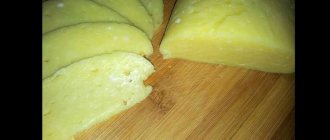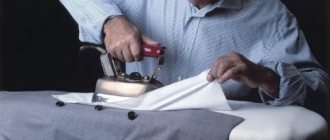Equal-armed home scales
Equal-arm homemade scales for measuring grams are similar to a swing; to perform them you need a level bar (ruler, knitting needle, level stick, etc.). “Cups” (small plastic bowls or bottle caps) are attached to the edges of the bar.
Three holes are punched in them at equal distances, into which a thread or fishing line is attached. A small strip is attached perpendicular to the center of the plank. It will play the role of an arrow that fixes the balancing of the shoulders. The scales are then secured to the stand and used effectively for their intended purpose.
Equal-arm scales, known to everyone from school, are made from a pencil, fixed with a heavy textbook on the edge of the table, and a ruler hanging on it in the form of a swing.
The pencil should be positioned exactly in the center of the ruler. This is called determining the center of gravity.
An object of a certain weight is placed on one end of the ruler, and the load to be measured is placed on the other end. In this way, you can weigh oversized objects whose weight does not exceed 50 g. Due to the fact that there is a danger that the ruler will break. There is also a danger that it will turn over and the bulk materials under study will scatter.
Using the indicated principle, simple scales are made for larger and heavier objects. Instead of a ruler, use a board, and instead of a pencil, take, for example, a log.
Simple equal-armed scales
We all once made this option from an ordinary school ruler and pencil in physics lessons. But over time, for some reason, many people forgot about them. And in vain, because it’s easy to make such scales, and the result will be accurate.
The main task is to position the pencil clearly in the center of the ruler. When the ruler lies perfectly flat on the pencil, you have found the center of gravity. Now you need to place an object on one edge of the ruler, and on the other - a load with a previously known weight. Small objects and bulk materials are weighed on a ruler. Their weight should not exceed 50 g. Otherwise, the ruler will break.
Using this principle, you can also make scales for heavier objects. The ruler needs to be replaced with a wide board, and the pencil with a cylindrical beam of suitable diameter.
But still, this option is not particularly convenient, especially for bulk materials, since there is always a risk that the ruler will turn over.
Shoulder scales
These are unequal weight measuring devices, since the bowls in this case move along the bar. Such devices will help to measure not only the weight of any objects, but also measure any bulk products
The bar for these scales is taken to be thin, and then it is more advisable to punch not a hole, but simply a groove.
Next, you need to install an arrow, for example from a needle or something similar, to record the deviation of the scales. The next step is to measure identical pieces in both directions from the center - the suspension point - and calibrate. It makes more sense to put notches there, since the bowls may slide off during the process of measuring weight.
Bowls can also be bottle caps, plastic cups and bowls, but here they are not fixed to a rail, but hung on strings.
Lever scales
Method 1
You need to take a long straight stick, a ruler, no shorter than 30 - 35 cm. In this scheme, it plays the role of a rocker.
The longer the rocker arm, the more accurate the results will be.
Next, you need to find the center on this “yoke”, measure equal segments on both sides of the marked center to install the bowls. Drill holes at these points. Secure a strong synthetic thread in the middle. Bottle caps or cut-off plastic cups are also suitable for bowls. Connect the threads from the bowls to the rail with a knot. Drill 3-4 holes along the upper perimeter of the cups at equal distances from each other, pass strong threads through them and tie them.
Make a scale arrow, you can cut out a cardboard triangle. Attach in the center of the rail where the main thread passes. Make sure that the stretched thread runs through the middle of the cardboard triangle. Hang the scales on a central thread on a support: a hook or a nail. Calibrate the scale.
IMPORTANT!
To ensure that the top of the triangle arrow in a suspended state clearly coincides with the stretched thread, you can stick a piece of plasticine to the bottom of a correspondingly lighter bowl.
Weights for such homemade scales can be found in a special store, either used as coins, or used the same tablets; their weight is indicated on the packages.
Method 2
Let's talk about another of the simplest lever scales. To do this, use a hanger hanging in any closet. Cups or bags are hung from both sides of clothes hangers. On one side, objects of known weight are placed in them. For example, factory-made packages with sugar and cereals are suitable; you can also take bottles filled with water.
Equal-armed scales
Equal-armed scales resemble a swing in appearance. So to make these you will need a straight shoulder bar. The role of this bar can be performed by an ordinary ruler, an umbrella knitting needle, or any other straight stick. You need to attach bowls to the edges of the plank. For these purposes, you can use any two identical containers. These could be drink caps, metal canning lids, measuring cups, etc. Along the edges of these containers, you should make three holes equidistant from each other and attach threads, fishing line, and thin wire to them.
How to make scales on the go
Many people have faced the need to measure the weight of something in nature. To solve this problem, you can make scales from plastic bottles. Identical vertical holes measuring 1 cm by 5 cm are cut in the sides of the bottle from the top closer to the neck. A stick or straw is inserted into them.
Either the object being weighed and a load of known mass, or two bottle caps are tied to its ends with strings. The object being measured is placed in one, and the counterweight in the other. It is logical that this device will allow you to weigh only light objects. But the principle itself is perfectly applicable in the case of large objects.
To do this, find a thick, strong stick, hang it by the middle to a strong knot or to a crossbar.
The stick should hang very evenly.
An object to be weighed and a load of known mass are tied to it from different sides. Its role can again be played by bottles of water, unopened packages of cereals/salt/sugar. It is not difficult to measure the approximate mass in this way.
How to make scales in nature
Sometimes in nature there is a need to weigh something. And this task is achievable. After all, you can make scales with your own hands from almost any available materials. You just need to apply a little imagination.
So, in order to weigh small objects, you can make scales from an ordinary plastic bottle. To do this, you need to make vertical slits closer to the neck and insert an even stick or straw into them. Tie either the object to be weighed and a load, or two bottle caps, to the ends on threads or ropes. Put what you need to weigh in one of them, and the counterweight in the other.
It is clear that with the help of such a device it is impossible to find out the mass of something heavy. But you can apply this principle using larger things.
You can make your own scales from a thick stick, which is tied to a tree or crossbar by the middle. It should hang perfectly straight. Then the object to be weighed is tied to the ends of this stick on one side and a load on the other. The only difficulty in the forest may arise from finding a load of known mass. Bottles of water, a bag of cereal, and cutlery are perfect for these purposes. It is unlikely that in nature you will need to weigh something with an accuracy of a gram. It is quite easy to find out the approximate weight with such scales. And the accuracy with a well-chosen load can reach an error of only 50-100 g per several kilograms.
Homemade scales for fairly large items
You can also weigh objects up to 100 kg at home or on the go.
To complete them you will need:
- steelyard,
- two very strong bars 1.5 and 1 m long
- strong twine
- cargo hook
The design itself is presented in the diagram below.
According to the diagram, it is clear that the values of 10 and 100 cm were not chosen casually. The data from the steelyard will need to be increased 10 times. It is necessary to accurately position the hole on block 1. You can use a clamp (a) to hang the object. Moving the clamp with a known weight along bar 1, you should determine its correct location and secure it in this place with a nail. If you need scales for loads over 100 kg, then the bars for the structure need to be longer. But the second one is always 10 times larger than the first one (for example, 15 and 150 cm, then the load should supposedly weigh up to 150 kg), and the steelyard indicators are multiplied by the length of the first one (in the example, by 15, respectively).
How to make your own electronic scales
Making electronic scales with your own hands is not the easiest task. First you need to carefully study the components and operating principle.
External components are:
- The weight processor is a separate block with a screen, keys, and microcircuits.
- A keyboard that should have working buttons “0” - “9”.
- Screen.
- Platform.
- A housing that hides all internal parts.
- Adjustable legs. For measurement accuracy, it is necessary to place the device level.
The measured load exerts pressure on it due to its gravity. Depending on the weight, the force of pressure of the measured object on the platform will change proportionally. Numerical values will be displayed on the screen.
The conversion of pressure data is facilitated by:
- Strain gauge
- Analog-to-digital converter ADC
- Microcontroller or processor.
Making scales with your own hands involves a careful study of each of the listed devices, their varieties, and a clear definition of what you need.
The heart of electronic scales can be considered a strain gauge. The strain gauge on which the strain gauge is based has a property that causes it to change resistance when deformed.
A voltage is sent to the strain gauge, and the output takes on a changed value, interacting with the strain gauge.
The analog-to-digital converter converts this voltage value into a digital code, which is then processed by the microcontroller. And the weight value is displayed on the screen. It happens in an instant.
There are several types of strain gauges:
- Single-point is built under the platform in the center. Used in trade, floor, packaging, technical and beam scales.
- Beam strain gauge. Intended, for example, for platform electronic scales.
- A rod strain gauge is required in particularly large scales - automobile, carriage, bunker. Used when weighing cargo from 20 tons.
- The S-shaped load cell is designed for overhead and crane scales.
- The double beam is used when weighing loads over 10,000 kg during transport weighing.
When choosing strain gauges, take into account the further conditions of its use. For high-quality functioning, they must be reliably protected from moisture and dust. Also, before installing the strain gauge, carefully study the connection diagram. An undamaged, high-quality wire must run from the strain gauge to the analog-to-digital converter.
Load cell
This strain gauge, used in the scale circuit, is a resistive bridge, the value of the resistance of the resistors in which varies depending on their mechanical deformation. Ideally, the output of the bridge under normal conditions (no forces act on the resistors) should have zero potential. That is, the bridge must be in a balanced state. The strain gauges I bought, on Aliexpress, had a white wire on the positive terminal, and there was voltage of negative polarity. In this case, you can simply load the sensor with such a weight that the voltage of the bridge signal goes into the positive region and programmatically make this voltage zero. This load can be a weighing platform with the appropriate weight. You can go another way. Since the electronic bridge is a symmetrical structure, you can simply swap the output signal wires, i.e. change the green wire with the white one. And apply the force in the opposite direction relative to the pointer on the load cell itself. When conducting experiments and debugging the program, I did just that. I won’t write about the HX711 module, because there is so much material on this topic on the Internet. I can only say one thing: the sensitivity of the microcircuit of the module of the same name is very high. This means that special attention must be paid to the quality of the supply voltage, the quality of installation, and the protection of the circuit from external electromagnetic interference. Otherwise, you will not achieve stable readings of the measured value.
The photo below shows the operation of the device without weighing and with weighing a weight of one hundred grams.
Here, tenths of the readings on the indicator are hundreds of milligrams. Tens and units of milligrams are not displayed, although their values are read from the microcircuit. The readings of these digits change too quickly with such a prototype installation of the device.
Now a little about the microcontroller program. After the entire classical register initialization procedure, the program for reading data from the memory of the DA1 ADC chip begins. This is followed by a zero correction subroutine. This program is activated every time the power is turned on. I did not include an additional button for this option in the circuit. Naturally, if you turn on the scale with the container installed on it, then its weight will also be subtracted from the total values and you will have a net weight on the indicator. Since all sensors cannot be made with the same parameters, this means that different sensors will have a different slope of the conversion characteristic - the dependence of the output signal level on the amount of force applied. Based on this, we will need to find a coefficient by which we will multiply the numerical value of the data received from the ADC. In my case, this coefficient is 1.1295. How to determine it. Turn on the scales, place a control weight, for example a 100g weight. Read the indicator readings, for me they were equal to 88.5347... Then divide 100g by 88.5347g and get the desired coefficient. Programmatically, we will naturally multiply by a number without a comma - 11295. That is. coefficient multiplied by 10000. After multiplying, we will not divide the resulting product back by 10000, but simply after converting a binary number to BCD, we will not display the four least significant digits, which corresponds to division. In hexadecimal code this number looks like: the high byte is 2C, the low byte is 1F. Below is the Disassembly Listing window, the addresses of the registers in which this coefficient lies are marked.
This is for people familiar with programming. Now for those who are not familiar with programming. The value of this coefficient can be changed in the specified program memory locations. In the Ic prog program
In the K-150 programs, everything is in the same place.
After the multiplication program there are programs for converting a binary number into a binary-decimal number and outputting information to the indicator. That's all for me. Good luck! K.V.Yu.
Homemade scales for a control hive
To find out the weight of the hives, folk craftsmen offer beekeepers several devices that they can make with their own hands. For example, the diagram shown in the following figure. To use this option, take blocks, scales, and steel cable.
The error is no more than 100 grams. The error can be determined by multiplying the accuracy of the scales by the number of blocks used.
A more complex installation already uses a strain gauge. The installation is securely fixed from below, a sensor, an electronic unit and a button to turn on the power supply are connected. They are placed in an easily accessible place.
The upper unfixed part, located on the lever, is connected to the base part using 2 springs. A frame consisting of an angle and bearings is attached to the base, a large nut is welded to it, and a handle is then screwed into the nut. The handle serves for subsequent lifting of the scales with the frame.
Starting to weigh the bee houses, wooden blocks approximately 5.5 cm thick are placed under the bottom of the hive. You can insert scales into the empty space under the hive. We press the power button, zeros appear on the screen (this is setting the autozero). By turning the handle, it rises and its weight is measured. Then we rotate the handle in the other direction to remove the load from the scales.
The entire design is based on conventional scales in a metal case, equipped with one strain gauge, 340 mm wide.
Using these scales, all bee houses are weighed. By determining how much an empty bee house weighs, you can very accurately find out the weight of the bee colonies themselves and the honey they produce.
It is known that beekeepers usually do not like electronic scales because of the need to switch to auto-zero every time after a measurement. In this method, before weighing, this is solved by turning the lever, this significantly reduces the time spent.
There are situations when it is necessary to measure grams. This is especially necessary when preparing any dish where its taste depends on the exact weight of the ingredients. Of course, in this case you can get by with a spoon or measure. But what about non-bulk products? For example, measure the weight of useful herbs for decoction. This article describes a simple device - a scale, which you can make with your own hands.
How to make scales?
An ordinary fifty-centimeter wooden school ruler will help us, which will serve as the main frame for our future scales. In the center of the ruler we drill a through hole for a wire loop on which we will hang the scales. Below the drilled hole (also in the center), glue an arrow, previously cut out of thick cardboard. Such an arrow is needed to determine the balance of our scales. By standing level with the wire loop, or leaning to the side, we will see an accurate determination of the weight on one side of the scale.
It remains to drill one hole on each edge of the ruler, as shown in the figure, for hanging the cups. The cups themselves can be made from plastic lids of the same weight. And as a fastening (suspension), use thick threads.
After the work has been done, we hang the scales in any place convenient for you, of course, with the condition that their work will not be limited by various obstacles, be it walls or other objects. A slight misalignment of the scales can be corrected by wrapping several turns of soft wire around the lifted edge of the rocker arm (ruler). Their number is determined by the position of the arrow in relation to the central wire loop. After the scales are set, and in our case, already configured, they are ready for work.
DIY strain gauges
To make strain gauges, you will need a steel plate (Figure 1). In our case it was a plate 190 x 40 mm with a thickness of 3 mm. Overall dimensions and thickness, of course, depend on the purpose you are pursuing when making scales, or more precisely on the weight range that is supposed to be measured on them.
We will also need rubber feet (Figure 2) and, in fact, 2 strain gauges. One strain gauge is measuring, the second is compensation. We used strain gauges (Figure 3). Overall dimensions of the substrate: 14 x 6 mm. Nominal resistance - 120 Ohm. Additionally, you will need special glue for gluing strain gauges to the bottom surface of future scales. We used Z70 one-component quick-setting adhesive.
Picture 1
Figure 2
Figure 3
Before gluing strain gauges, the surface of the metal plate must be thoroughly cleaned and degreased. The measuring (working) strain gauge is glued along the plate, the compensation one is glued across it (Figures 4, 5 and 6).
Figure 4
Figure 5
Figure 6
After the glue has dried, it is necessary to solder the wires to the contact pads of the strain gauges according to the diagram in Figure 7 (in our case we use a half-bridge circuit). Rmeas is a measuring resistor glued along the plate. R1 is a compensation resistor glued across the plate. We used MGTF wire with a cross section of 0.12 mm2. Next, it was woven into a “braid” and “grabbed” to the surface of the plate with two-component POXIPOL glue (Figure 8).
Figure 7
Figure 8
After this, it is necessary to cover the surface of the strain gauges and soldering points with a protective varnish (see Figure 6), which prevents mechanical damage to the strain gauges. We used nitrile rubber varnish NG150.
After the varnish has dried, you can say with confidence: “The scales are ready!”
All that remains is to connect them to the ZET 7010 module to carry out measurements. The connection of wires coming from the scales is carried out in accordance with the connection diagram shown in Figure 7. The circuit is powered from the ZET 7010 module. The measurement results can be displayed on the ZET 7178 digital indicator or connect the ZET 7010 module to a computer using a ZET 7070 interface converter.
Figure 9
The current value of the force applied to the scales can be displayed on the indicator (program “DC Voltmeter”). To plot a graph of the applied load, the “Multi-channel oscilloscope” program is used, and to monitor the parameters of strain signals, the “Multi-channel recorder” is used.
Figure 10 — Graph of applied load
Examples of homemade lever scales, how to make lever scales:
In order to make a lever scale, all you need is: a platform, a tripod (can be made of wood or plexiglass), and a lever (it can be cut from a sheet of iron), and, of course, cups for the weight. The design of this kind of scales is so simple (as is the principle of their operation) that only separate explanations are needed in Figure No. 1.
Figure No. 1 – Design of lever scales
Figure No. 1 shows that the platform has set screws - they are necessary to level the scales (by screwing or unscrewing them) - this is important for weighing. The scale should be level, and you can even attach a water level to your structure. I would also like to draw your attention to the so-called “stopper”, Figure No. 2.
Figure No. 2 – Sketch of some structural elements
A stopper in lever scales is necessary so that the counterweight does not fall, and you do not have to level them every time, in short, for ease of use.
Of course, if you wish, you can do without a stopper and counterweight - it is also convenient to use a design with an elastic band or a simple spring, Figure No. 3.
Figure No. 3 – Lever scales with an elastic band instead of a counterweight
But be warned! There is one difficulty - choosing an elastic band that is suitable in strength.
Setting up lever scales:
To set up a lever scale, you will need a set of weights, or something with a strictly defined and pre-known exact weight. The pointer position without the weight will be your zero reference. Next, simply place the weight on the cup and see how much the scale arrow deflects - this will be your maximum measurement limit. You can maneuver the measurement limits by changing the force of the counterweight (use larger or smaller counterweights)
PS: I tried to clearly show and describe non-tricky tips. I hope that at least something is useful to you. But this is not everything that can be imagined, so go ahead and study the site https://bip-mip.com/
- Do-it-yourself drilling machine Drilling holes in printed circuit boards is something almost every radio amateur faces.
- Homemade winding machine You can wind a coil, a transformer, wind threads from a ball, you can do it all.
- Do-it-yourself thermal jigsaw For figured cutting in low-melting sheet materials, it is convenient to use this way.
- DIY jewelry jigsaw A jewelry jigsaw, having a significant advantage over an ordinary jigsaw, can come in handy.
- Lever pressSometimes there is a need to press something hard, crush it, or split it with something.











